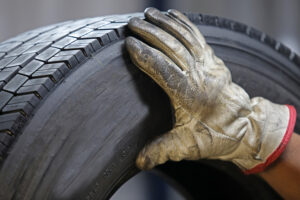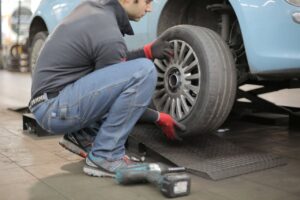4 Signs Your Car Needs New Tyres
Replacing tyres is often overlooked, but is an extremely vital part of car maintenance. This is as tyres are the only part of your vehicle that actually come in contact with the road. So how do you know when your car needs new tyres?
A lot of motorists don’t know how to check their tyres or how often to buy new ones. This is why we’ve compiled 5 tips to help you establish if you’re in need of new ones.
Ineffective Tread Depth
New tyres come with at least 8mm of tread depth. This allows them to maintain excellent contact with the road surface. However, over time, tread begins to wear away. It is then your responsibility to ensure the tread depth of the tyres doesn’t drop below 1.6mm.
The way you can test this is by carrying out the 20p test. This consists of taking a 20p coin and placing it in the main groove of the tread. If you can see the outer ring (the shiny rim of the coin), it means the tyre is too worn. You can repeat this a few times around the circumference to establish whether the tyre has worn unevenly.
Alternatively, most professionals and car garages stock tyre tread depth gauges. Therefore, if you want that bit more comfort in knowing your tyres are either safe or too dangerous for roadworthiness, you can check your tread depth with it or ask a professional to show you how.
Remember, if you’re caught with tyres that are under the legal tread depth, it will be classed as dangerous and you could end up with a fine and points on your licence. The maximum fine would be £10,000 and a fine of up to 12 points.
Old Tyres
On the other hand, tyres with a lot of tread depth may also need changing. Especially for road users that use their cars more often than others. Over time, tyres will be exposed to a range of external conditions such as ice, UV rays. chemicals and road salts that could cause the quality to deteriorate.
It’s important to check the condition of your tyres on a regular basis as part of standard car checks. However, you should try to get it inspected by a professional once they reach 5 years old.
Likewise, even storing a vehicle incorrectly can cause the health of tyres to significantly cause damage. Therefore, it is important to check your tyres even when your vehicle has been standing for a long period of time.
Most tyres on the market will begin to degrade after 10 years. However, it is worth noting that others may begin to decay far quickly. This can depend on your car and your driving style. Moreover, if you are unsure of the age of your tyres, just check your vehicle manufacturers guide or the four-digit code on the sidewall of the tyres.
Experiencing Bad Vibrations
If you’re noticing that your car is vibrating whilst driving, it could mean that your wheel alignment is ineffective. This can be down to shock absorbers, but it could also be an issue with your tyres.
To test if you can feel more vibration from the road than usual, aim to find a newly resurfaced road. If it’s still vibrating and loud when driving over smooth tarmac, it will need to be checked as soon as possible.
If you don’t have enough tread depth, you’re almost guaranteed to have a bumpy ride. Vibrations alone don’t mean that your tyres need to be changed. However, it could be an indicator that they have suffered from excessive and prolonged wear. Thus, any form of vibration should be looked at as soon as possible. This can be done by taking your vehicle to a professional which will look closely at the condition of your tyres.
Cracks and Holes in the Tread
Whilst inspecting your tyres, you should look out for any cracks in your tyres. A crack in the sidewalls of your tyres could be an early warning sign for a potential blowout. If you can catch it at the correct time, you are preventing a highly dangerous accident. This heightens, especially if you were to be driving at a high speed.
Moreover, if there is a large hole in the tread, it’s essential that you get it replaced as soon as you can. This sort of damage can worsen over time. Therefore, making way for a multitude of issues such as bad grip, traction and lack of control.
How often should you check your tyres? Ideally, it’s said that you should check them once a month. However, if you’re planning a long journey, always make sure you check them before and after. Additionally, pay close attention to engine fluids, brakes, lights and windscreen wipers.
It’s vital that your tyres are at optimal condition before weather conditions change. Harsh driving such as snow, ice and rain can worsen existing problems in a tyre. These simple steps could prevent you from being fined, receiving penalty points and protecting you and other road users from accidents or injuries. If you are ever in doubt, take your vehicle to a car professional.
There you have it. You know exactly what to look out for when checking your tyres. If you do need a new set of wheels, check out our massive range of stock on our site here. For any other advice or guidance on your tyres, check out our official blog page.




